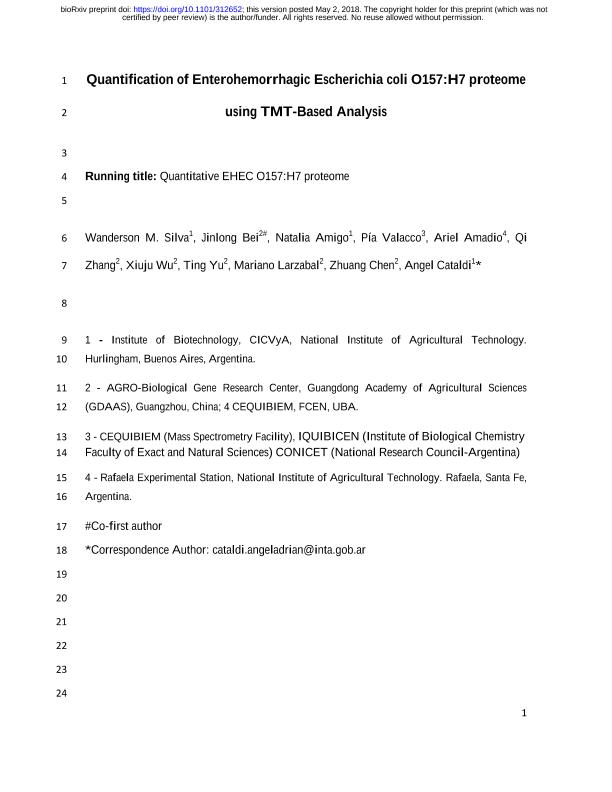Artículo
Quantification of Enterohemorrhagic Escherichia coli O157:H7 proteome using TMT-Based Analysis
Marques Da Silva, Wanderson ; Bei, Jinlong; Amigo, Natalia
; Bei, Jinlong; Amigo, Natalia ; Valacco, Maria Pia
; Valacco, Maria Pia ; Amadio, Ariel; Zhang, Qi; Wu, Xiuju; Yu, Ting; Larzabal, Mariano
; Amadio, Ariel; Zhang, Qi; Wu, Xiuju; Yu, Ting; Larzabal, Mariano ; Chen, Zhuang; Cataldi, Angel Adrian
; Chen, Zhuang; Cataldi, Angel Adrian
 ; Bei, Jinlong; Amigo, Natalia
; Bei, Jinlong; Amigo, Natalia ; Valacco, Maria Pia
; Valacco, Maria Pia ; Amadio, Ariel; Zhang, Qi; Wu, Xiuju; Yu, Ting; Larzabal, Mariano
; Amadio, Ariel; Zhang, Qi; Wu, Xiuju; Yu, Ting; Larzabal, Mariano ; Chen, Zhuang; Cataldi, Angel Adrian
; Chen, Zhuang; Cataldi, Angel Adrian
Fecha de publicación:
05/2018
Editorial:
Cold Spring Harbor Laboratory Press
Revista:
BioRxiv
ISSN:
2692-8205
Idioma:
Inglés
Tipo de recurso:
Artículo publicado
Clasificación temática:
Resumen
Enterohemorrhagic Escherichia coli (EHEC) O157:H7 is a human pathogen responsible for diarrhea, hemorrhagic colitis and hemolytic uremic syndrome (HUS). EHEC infection is distributed worldwide and numerous outbreaks of diseases caused by enterohemorrhagic have been reported. To promote a comprehensive insight into the molecular basis of EHEC O157:H7 physiology and pathogenesis, the combined proteome of EHEC O157:H7 strains, Clade 8 and Clade 6 isolated from cattle in Argentina, and the standard EDL933 (clade 3) strain has been analyzed. TMT (Tandem Mass Tags)-based quantitative proteomic and emPAI analyses were performed to estimate the protein abundance in EHEC proteome. 2,234 non-redundant proteins of EHEC O157:H7 were identified. A comparison of this result with in silico data of EHEC O157:H7 genome showed that approximately 40% of the predicted proteome of this pathogen were covered. According to the emPAI analysis, 85 proteins were among the most abundant (e.g. GAPDH, FliC H-antigen, Enolase, and GroEL). Tellurite resistance proteins were also highly abundant. COG analysis showed that although most of the identified proteins are related to cellular metabolism, the majority of the most abundant proteins are associated with translation processes. A KEGG enrichment analysis revealed that Glycolysis / Gluconeogenesis was the most significant pathway. On the other hand, the less abundant detected proteins are those related to DNA processes, cell respiration and prophage. Among the proteins that composed the Type III Secretion System, the most abundant protein was EspA. Altogether, the results show a subset of important proteins that contribute to physiology and pathogenicity of EHEC O157:H7.IMPORTANCE The study of the abundance of proteins present within a complex mixture of proteins in a cell, under different conditions, can provide important information about the activities of individual protein components and protein networks that are cornerstones for the comprehension of physiological adaptations in response to biological demands promoted by environmental changes. We generated a comprehensive and accurate quantitative list of EHEC O157:H7 proteome, which provides a description of the most abundant proteins produced by this pathogen that were related to physiology and pathogenesis of EHEC. This study provides information and extends the understanding on functional genomics and the biology of this pathogen.
Palabras clave:
EHEC
,
PROTEOMIC
,
SECRETION
,
QUANTIFICATION
Archivos asociados
Licencia
Identificadores
Colecciones
Articulos(SEDE CENTRAL)
Articulos de SEDE CENTRAL
Articulos de SEDE CENTRAL
Citación
Marques Da Silva, Wanderson; Bei, Jinlong; Amigo, Natalia; Valacco, Maria Pia; Amadio, Ariel; et al.; Quantification of Enterohemorrhagic Escherichia coli O157:H7 proteome using TMT-Based Analysis; Cold Spring Harbor Laboratory Press; BioRxiv; 5-2018; 1-35
Compartir
Altmétricas



